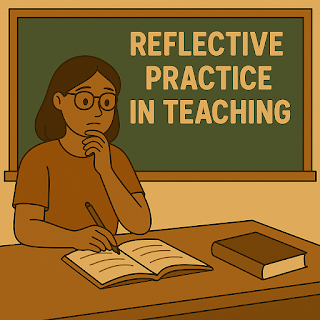Reflective Practice in Teaching
Reflective practice is the process by which teachers critically examine their teaching methods, decisions, and outcomes to continuously improve their effectiveness in the classroom. It turns everyday experiences into opportunities for growth.
🔍 What Is Reflective Practice?
“Reflection is the heart of effective teaching.” – Donald Schön
Reflective practice involves thinking deeply about:
-
What worked well?
-
What didn’t work?
-
Why did students struggle or succeed?
-
How can I do better next time?
🧠 Types of Reflection
| Type | Description |
|---|---|
| Reflection-in-action | Thinking while teaching and making immediate changes. |
| Reflection-on-action | Thinking after a lesson to review what went well or poorly. |
| Reflection-for-action | Thinking before teaching to plan improvements for next time. |
-
Describe the teaching event or experience.
-
Analyze what happened and why.
-
Evaluate the strengths and weaknesses.
-
Decide what to change or continue.
-
Apply the insights in future lessons.
🧰 Tools for Reflective Practice
| Tool | Use |
|---|---|
| 📝 Reflective Journal | Regularly write down classroom experiences and thoughts. |
| 🎥 Lesson Video Recording | Record your teaching to observe your techniques and student reactions. |
| 👥 Peer Observation | Invite colleagues to observe and give feedback. |
| 📊 Student Feedback | Use surveys or exit slips to understand student perspectives. |
| 🧭 Self-assessment Rubrics | Rate your lesson design, questioning techniques, or classroom management. |
-
Improves instructional quality
-
Builds self-awareness and confidence
-
Enhances student engagement and learning
-
Encourages innovation and adaptation
-
Fosters professional growth
🏫 Examples in Practice
-
A teacher realizes students are disengaged during lectures → switches to interactive group activities.
-
After a noisy class, a teacher reflects and adjusts classroom rules or seating arrangements.
-
A science teacher notices students struggle with abstract concepts → adds visual aids or simulations.
📚 Reflective Models You Can Use
| Model | Key Stages |
|---|---|
| Gibbs’ Reflective Cycle | Description → Feelings → Evaluation → Analysis → Conclusion → Action Plan |
| Kolb’s Experiential Learning | Concrete Experience → Reflective Observation → Abstract Conceptualization → Active Experimentation |
| Brookfield’s Four Lenses | Self, Students, Colleagues, Theory |
Reflective practice transforms teaching from a routine job into a dynamic, evolving profession. It empowers educators to be intentional, responsive, and learner-focused.

Comments
Post a Comment
Friendly & Inviting:
We'd love to hear your thoughts — feel free to share a comment below!
With Moderation Reminder:
Comments are moderated. Your comment will appear once approved.
With Community Guidelines:
Please be respectful and stay on topic. Spam and rude comments will be deleted.